World Records Seen From Above
I shot most everything from overhead today, either with the use of remote cameras or by physically shooting from the catwalks. Here is Andrei Rybakou of Belarus winning the silver medal and breaking the world record with an 185 Kg snatch in the men’s 85kg weightlifting competition. This was shot with an overhead remote camera–more on that later…
I also photographed U.S.A.’s Natalie Coughlin winning the bronze in the women’s 100-meter freestyle. I really like this frame as she’s still under the water (which was obviously not still) and the resulting image almost looks painterly. I photographed Natalie when she was just 15 years old at the Santa Clara swimming competition years and years ago–I still remember that day clearly. She was such a sweetheart and I made a portfolio image (that is still in my portfolio today) of her that day after a coach told me she would be the “next big thing…”
Here is another remote camera photograph. I went very early to the swimming venue this morning to make sure I could get on the catwalk–and also to mount a side remote. The idea is that I would trigger it from above (while shooting with a 400mm lens) and have this camera mounted to the right with a 200mm lens on a high resolution body. Here you can see U.S.A.’s Ryan Lochte pushing off to win the gold medal in the men’s 200-meter backstroke with teammate Aaron Peirsol just above him. The arch in these guys bodies never ceases to amaze me. This is a standard remote angle–but one that always yields good results. Speaking of which …
Here is Lochte pumping his fist from that same remote. You can see the dejection in all of the other swimmers’ faces quite clearly, especially in Peirsol’s. It must be a very bittersweet experience to see your teammate win.
Here’s a little background on how these images were made. The following photograph is of my friend Harry How of Getty Images who shot side by side with me. I would have liked to have shown you a variety of shots, including a wide angle view of what it feels like to be up there, but we’re only allowed to bring up one lens and one camera body–no exceptions!
Going up on a catwalk to photograph the swimmers from above is a true privilege (almost as nice as watching all of those neat television angles with the overhead cam and underwater cameras–man, I wish we had the budget to do stuff like that with still cameras), but getting up took a lot of work. First we had to get approved by the overall photo manager that oversees all Olympic photographers and each venue. Putting up a remote camera overhead (or shooting from there) is a huge liability, and the process and paperwork is intense–but well worth the extra effort. Of course, even though I had gotten the proper authorization from both the venue manager, and the chief venue manager 24 hours in advance, they still didn’t have my name on the list at 7 a.m. this morning. Luckily I know the venue manager at the Aquatics center Peter Charles from past Olympics including Athens and Torino (he’s actually an “adviser” and technically the assistant venue manager but we all know he’s the man in charge) and he worked things out.
Once you are approved, you gear up an hour before the race and have to follow the following rules: one camera, one lens, one card. Nothing else.
But getting a photograph of Phelps from above is priceless–so it’s all worth the hassle. Here he is winning gold in the 200 meter individual medley. This was shot with a 400mm 2.8 handheld–oh yeah, hand holding a 12 pound lens ain’t easy. Luckily it was strapped to me–and I to the catwalk with oodles of safety cables. We weren’t allowed to being extra CF Cards or even a paper start list, which is pretty extreme if you ask me. We were patted down before we went up by the photo escorts, and we all tried to get things in–even our credentials were left behind. While extreme, I agree with one of the photo escorts who said that if even one sheet of paper floated harmlessly down from the catwalk. it would be game over for everyone–no more catwalk access. So we just had to grin and bear the restrictions. I would have liked to have had another card in my pocket, a wideangle–maybe a zoom–but that wasn’t in the cards.
Here’s a tighter version of Phelps on his second swim of the day, this time shot w/ 1.4X converter on the 400mm 2.8. Hey, it was mounted on the camera, so technically there weren’t any loose items, right? And yes, someone did sneak in a start list with the names of all the swimmers and what lanes they would be in–otherwise we would have been totally lost up there! It was a total blast to shoot from the catwalk, btw–you can see how the swimmers’ bodies move through the water, and I found it to be completely mesmerizing to watch the swimmers kicking their legs under water in such violent yet beautifully rhythmic patterns. You can really appreciate the race from up there, and it’s one of the few spots from which you can truly tell who’s in the lead.
Oh and another cool thing is that I got to touch the bubble ceiling of the water cube–very cool, kind of like an inflatable rubber medicine ball.
My next stop was the weightlifting championships for the 75KG women and the 85KG men. That too involved remotes, as you can see from the first picture in this post. I used a few remotes at that venue.
While putting up a remote can lead to incredible images, it also has its disadvantages It turns your 8-12 hour day into a 20 hour day–you have to put the remotes up at 6-7 a.m., leave them in position all day, and wait until the last event in the venue is completed–often after 11 p.m. It’s a huge time commitment and truly limits your mobility and ability to change your plans mid-day. You also are constantly thinking of when to fire the camera and when not to. You can fire your remote every time you fire your floor camera with radio remotes called Pocket Wizards (all of the ones I brought here are on custom frequencies that I had done prior to the Olympics–this ensures that no other photographer will accidentally trigger your remote.) Then you also have to worry about battery life, and, most important, not running out of space on your cards. I use the 22 Megapixel Canon 1Ds MKIII and it’s a hog when it comes to files–each actuation (click) takes up 24 Megabytes–and that adds up really quickly. Luckily Lexar gave out some 4GB SD Cards to each photographer at the Olympics–and I also got my hands on a spankin’ new 16GB 300x card–the first of its kind in the market–giving me a whopping 20 Gigabytes in one camera. Now there’s a game changer!
So I was able to shoot head on with a 400mm 2.8 knowing I had it covered with an overhead remote as well. Here’s Lei Cao, of China,winning the gold in the women’s 75kg weightlifting competition and setting a new Olympic record.
Allow me to walk you through the setup I had at that venue. I was shooting with a 400mm 2.8 (and 300mm 2.8) on a monopod–this is the shot I got when Andrei Rybakou, of Belarus, won the silver medal and broke the world record with an 185 Kg snatch in the men’s 85kg competition.
I also mounted a 70~200mm 2.8 on a Canon 1Ds MarkIII body right in front of me. Every time I triggered my main camera (on the monopod) the radio transmitter atop the hotshoe of my camera sent out a trigger signal to this looser camera.
This allowed me to shoot tight handheld and trigger the high resolution body in front of me. If the weightlifter had jumped up instead of falling to his knees, I would have had a backup loose frame–the resolution of the 1Ds is so high that you can easily crop a vertical out of this frame without any hesitation.
And each time I fired off my main camera, the same radio signal also fired the overhead remote. Here is the frame you saw at the start of this blog–but this time full frame…
As you can see it was a very graphic frame–and it allowed for the lifter falling to his knees and also backwards–or anything else unexpected–as long as he looks up at some point, you’ve got a frame.
And here’s yet another frame from the same remote during the medal ceremonies:
So you see–photographers CAN be Houdinis of sorts, being at more than one place at a time. As I mentioned, remotes are incredibly time-consuming. And they have a terrible tendency not to fire at all on big moments. Metal sucks in radio signals, and most stadiums are full of metal… especially catwalks. Batteries die, remote cords fail, signals don’t reach and cameras get bumped by others, slip just one millimeter to the left or down, of the focus is slightly off–if any of these things happen, you’ve got ZIP to show for all of that work. Three of us had remotes up there tonight, and I can tell you that we all exhaled when we went up there and saw that there were actual images recorded on those cameras. It’s incredibly stressful even for veterans; you never know if it works until you see the images (and in the film days confirmation would take a MUCH longer time.) These days photographers are running AC power and hundreds of feet of ethernet cable to the remotes and dragging the images down from below via WIFI transmitters connected to the camera via a laptop below. Technology never ceases to amaze me–Mark Terrill of the AP was one of the first to do the WIFI thing years ago at the Lakers game–I’ll never forget hearing about that. The photographers who have underwater cameras at the swimming venue are sitting there with their laptops during the race watching images stream in from the underwater cams seconds after they were shot (ethernet or USB cables with repeaters are below the surface…)
Here’s a quick shot from outside of the Wrestling Venue at sunset..
I’ll leave you off with the following anecdote from today titled: How One Minute at the Olympics Can Cost You 40 Minutes….
At the end of the wrestling match I had to wait for the medal ceremony to finish before I could pull down the remote camera from above. And I only had 15 minutes before the next bus left. Once I got back down from up there (and let out a big sigh because all the effort had yielded a picture or two) I had what I call a classic and true Olympic photographer’s moment: I had to pack 2 remote kits–one 300mm and another 400mm lens with 4 camera bodies and all of the remote cables, magic arms, safety cable, remote cables–while simultaneously copying 3 cards of RAW files into my laptop–within the next 5 minutes if I had a prayer of making the next bus. I was already sweating profusely from going up and down from the catwalk (you have to climb a 20 foot ladder with all of the gear) and I had a deadline of 9:30 p.m to catch the bus.
Somehow I managed to pack everything in time to make the 9:30 bus with one minute to spare–and I was dripping sweat. I had beads of sweat coming down my nostrils, and other from my brow falling onto my glasses. But of course, as it turns out, the buses were leaving every 20 minutes–not every 30 minutes–so the one I was on would leave at 9:40 p.m. Now I’m praying we’ll make it to the main press center in time to catch the 10 p.m. bus to the hotel–if not, I’ll have to wait for the 10:30 p.m. bus… and the guide on the bus informs us that the ride will be approximately 25 minutes. OY VEY–this is going to be tight…
Luckily we don’t hit traffic, but right as we pull up to the main press center I can see that all of the 10 p.m. buses are pulling away. We’re 30 seconds late, and that’s an eternity in a country that strives to run like clockwork. As I type this, our (now 10:30 p.m.) bus driver is perched out of one of the side windows with half of his body leaning up and out of the bus, buffing the exterior with a rag. He’s making sure that his shoes don’t touch the seats. It’s an amazing sight– this guy must have been a former gymnast. Well I gotta go–if you’re reading this now, I guess that I made it. Tomorrow is a huge day. There’s a chance Phelps could lose his record-tying race (to Spitz’s metal record) tomorrow–SURE HOPE NOT! And of course if the big daddy of Athletics–the Men’s 100M final – late tomorrow night. Time to get some rest!


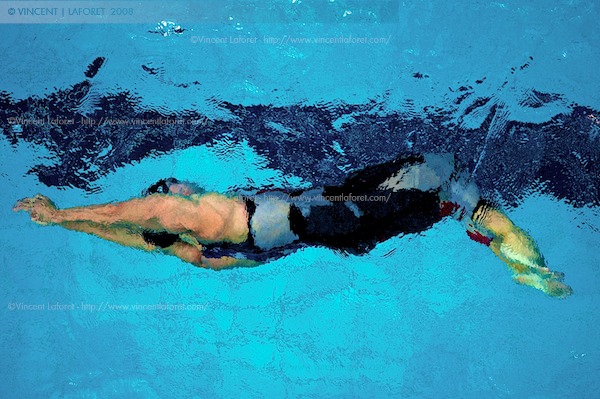
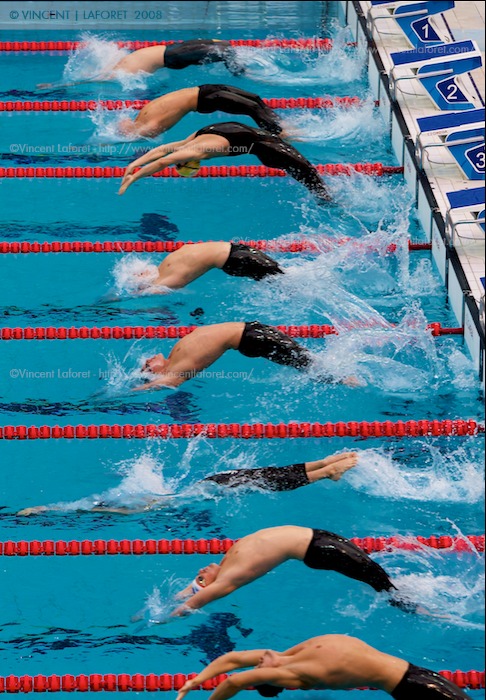
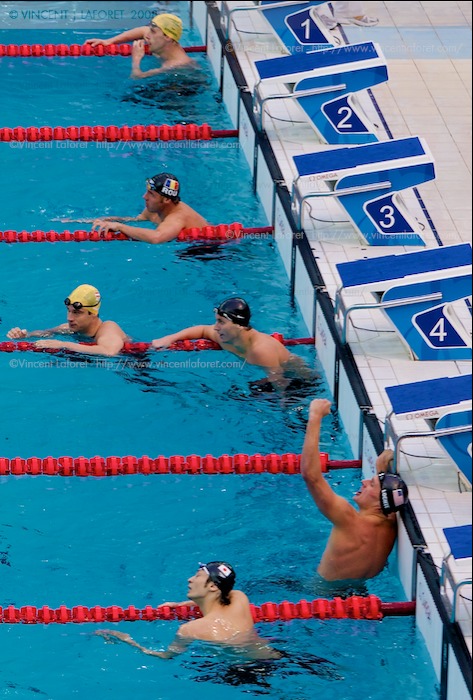

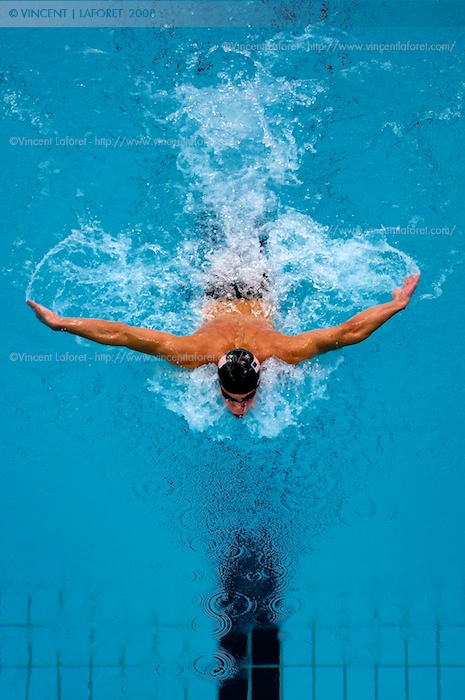
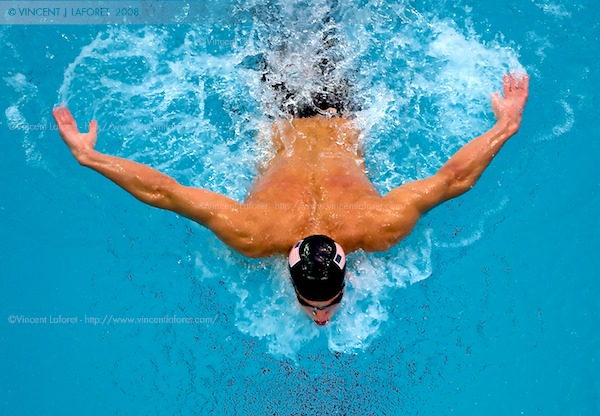
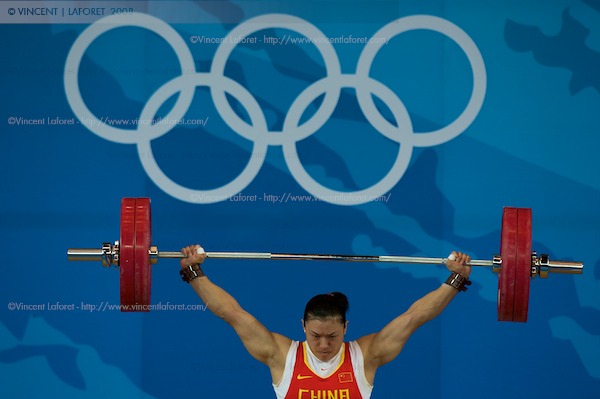


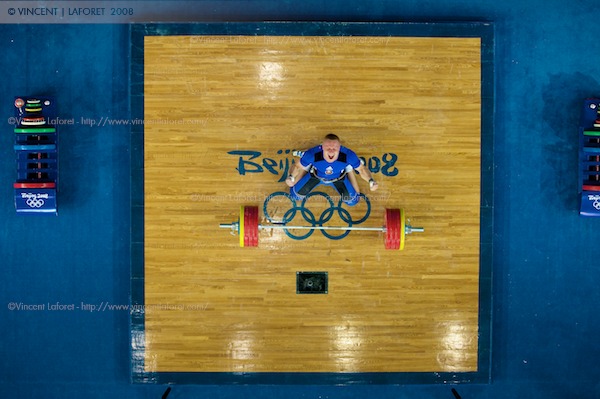
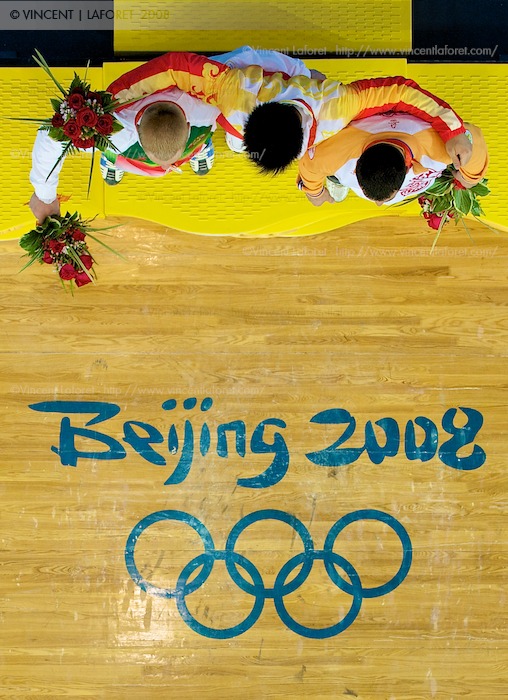
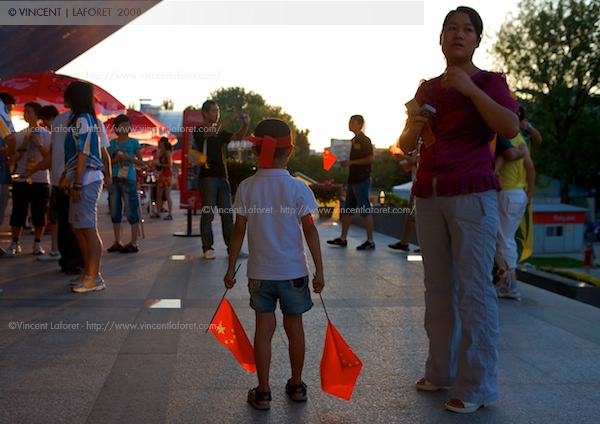












This is a fantastic shot…Probably my favourite of what you’ve posted so far. Thanks for your updates…even if our poor Canadians are having a dismal outing so far, your blog has been great to follow…
Cheers…
Awesome, just awesome. You’re blog is quite inspiring and a great read.
Great photo. But how could he break the WR and be silver? Wouldn’t the gold winner have to break his record in order to be gold?
I love your crop on this.
Thiago, the gold medal winner of the 85 kg mens weightlifting event (Lu Yong of China) lifted the same weight as the World Record Setter (Andrei Rybakou of Belarus) thus tying his total. In Olympic weightlifting ties are broken by body weight, so Yong’s lighter body weight allowed him the gold.
I do some weightlifting at least twice a week, weightlifting is a very good exercise and it keeps the shape of my chest and shoulder muscles in very good form.+
Usually I don’t read article on blogs, but I wish to say that this write-up very compelled me to check out and do it! Your writing style has been surprised me. Thanks, quite great article.
I think that is one of the so much important info for me. And i am glad reading your article. But wanna statement on some general issues, The web site style is wonderful, the articles is in point of fact excellent : D. Excellent activity, cheers